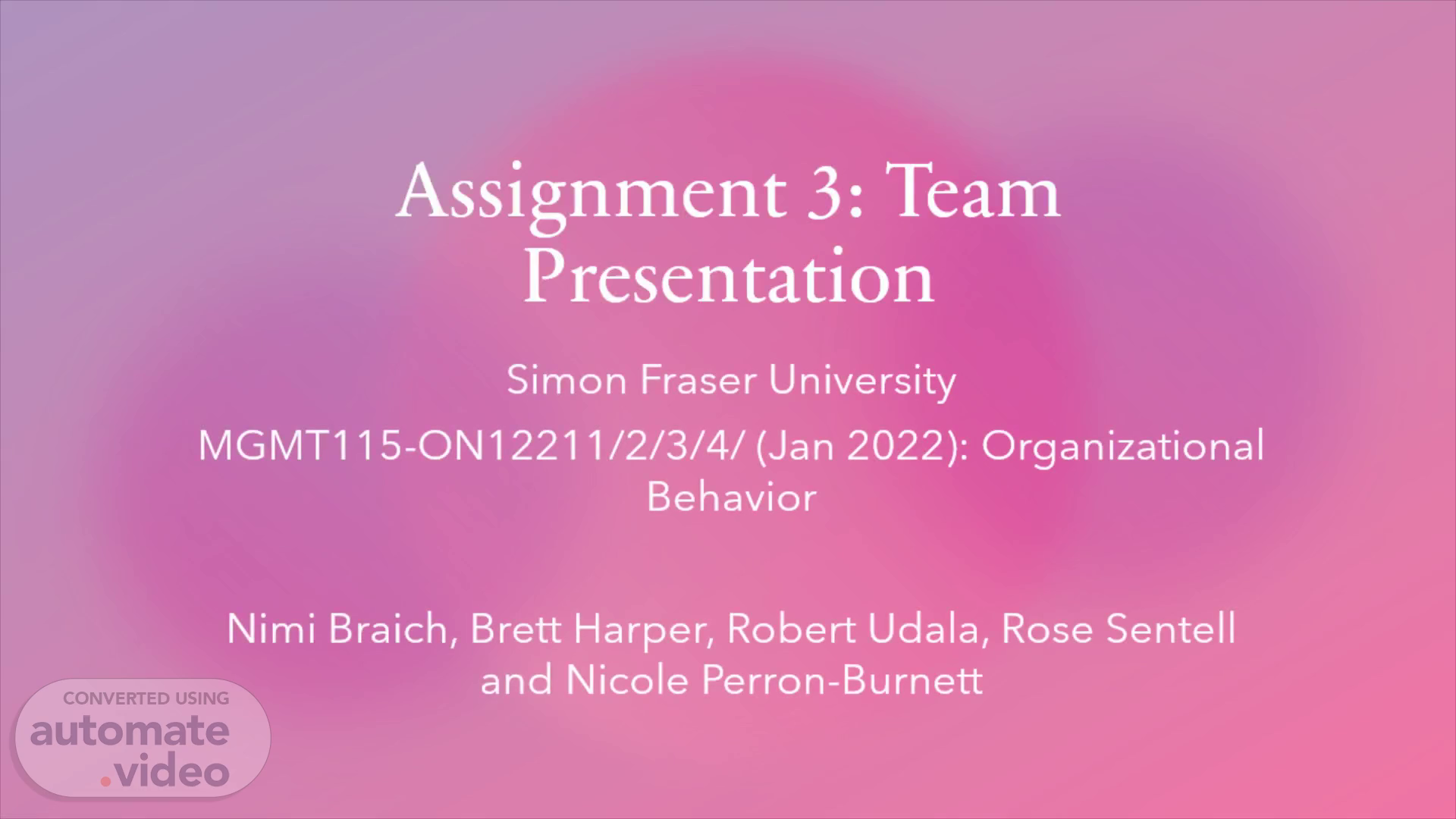
Page 1 (0s)
Assignment 3: Team Presentation. Simon Fraser University MGMT115-ON12211/2/3/4/ (Jan 2022): Organizational Behavior Nimi Braich , Brett Harper, Robert Udala , Rose Sentell and Nicole Perron-Burnett.
Page 2 (13s)
Introduction. 3/13/2022. Assignment 3: team presentation.
Page 3 (58s)
M – Motivation. MARS model refers to internal psychological forces that influence employee behaviours Motivation, Ability, Role Perception and situational factors “Motivation is a force that exists within individuals” Motivation can be measured by intensity, direction and persistence Intrinsic and extrinsic motivation.
Page 4 (2m 53s)
A – Ability. What is meant by Ability? Ability is the “Ability includes both learned capabilities and natural aptitudes to successfully complete a task.” Can ability be learned? Yes, through training and development OR It comes naturally Insert Audio Example: (audio only) Ability influences people’s behaviours.
Page 5 (4m 55s)
R – Role Perceptions. Role perceptions is the ability of individuals to understand what is expected of them. It is the employees’ impression of their expected obligations..
Page 6 (6m 43s)
S – Situational Factors. The last letter in MARS, S, “represent[s] Situational Factors, [which] are external to the person, but would affect their behaviour and performance. Examples of situational factors include the office environment, resources, and how the organizational structure supports or impedes the change in the behaviour .” (Ning, 2020).
Page 7 (8m 47s)
Counterproductive Workplace Behaviors. CWBs can be divided into three categories: (1) those that benefit the self; (2) those that benefit the organization and; (3) those that inflict damage ( Vardi & Weiner, 1996). People with lower integrity are more likely to engage in CWBs ( Mikulay et al., 2001). Individuals with a more tolerant attitude towards CWBs are more likely to engage in them (Moretti, 1986). Normalization of CWBs among group members increases likelihood of an individual engaging in CWBs ( Mikuay et al., 2001). Organizations with a more permissive attitude towards CWBs are likely to suffer higher rates of CWBs committed by employees than organizations where attitudes clearly condemn those behaviours (Kamp & Brooks, 1991). 2 aspects pertaining to risk help inform whether a person will engage in CWBs: (1) perceived likelihood of success without being caught and; (2) perceived consequences ( Ajzne , 1991). Desired outcomes of CWBs can vary and may include personal gains or hurting others ( Mikulay et al., 2001). People expect an organization to pay them what they have earned (Berkowitz et al., 1987). CWBs can be an attempt to rectify perceived inequity ( Lasson & Bass, 1997). Research indicates that pay inequity increases instances of CWBs (Greenberg, 1990). Estimates suggest that CWB account for anywhere from 20% (Coffin, 2003) to 33% (Furnham & Taylor, 2004, as cited in Atamanik -Dunphy, 2009) of failed business. Estimates suggest that CWBs may carry an annual cost of anywhere from 50 billion dollars (Coffin, 2003) to upwards of 200 billion dollars (Murphy, 1993, as cited in Atamanik -Dunphy, 2009). CWBs can have a negative impact on co-worker morale and overall company image ( Slora , 1989). Companies that suffer from poor employer branding can find it difficult to hire quality employees and thus can flounder ( Dessler & Chhizner , 2019)..
Page 8 (11m 34s)
Employee Turnover. How does Turnover relate to employee motivation & organisational performance?.
Page 9 (13m 30s)
Employee Attendance. Internal motivation and responsibilities Demotivated staff have higher absences, time off and are less engaged MARS model increases motivation levels Return on investment on disengaged staff Root Cause of unmotivated employees.
Page 10 (15m 32s)
Conclusion. 3/13/2022. Assignment 3: team presentation.